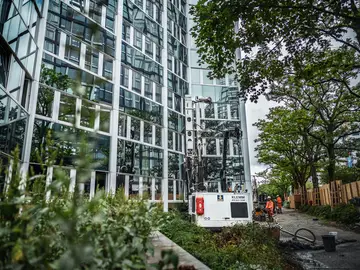45 geothermal probes for "MERGENTHALER": Bauer Resources is building a geothermal heating system
Eschborn, Germany – Wherever you look, construction space is scarce in city centers. Sooner rather than later, cities will have to react to the situation. Unused buildings can offer a real opportunity here. So how about an abandoned factory? Or an old office complex? Sounds unrealistic, but it's not. The key word is revitalization. One classic example of this is the "MERGENTHALER" project in Eschborn, Germany: A vacant office building from the 1980s is to be revitalized by 2024 using resource-efficient and CO2-reducing methods on behalf of the Munich-based real estate company WÖHR + BAUER. The core element of this project is a sustainable energy concept – which is exactly why BAUER Resources GmbH is building a geothermal heating system.
Meter by meter into the depths
Preparations began in spring 2022. The geothermal probe field was planned precisely in advance to avoid damaging any underground pipelines during drilling. "This is a crucial step, especially with existing buildings," remarks Marcel Moesslang, Project Manager at BAUER Resources GmbH. Once planning was finished, he and his team produced the geothermal probes using the flush drilling method. The principle: A drilling rig drills hole after hole and injects a special drilling mud slurry into the subsoil at high pressure. This extracts the slurry as well as the drilling debris so that the probes can be installed afterwards. In this way, holes deeper than 100 m were drilled for 45 geothermal probes.
Piece by piece with great accuracy
As with many inner-city projects, the limited space for construction sites was a major challenge, the Project Manager emphasizes: “Working with the large machines in narrow spaces was challenging. With a distance of less than 2 m from the building, our drilling work had to maintain the specified distances from the property line. Every move has to be spot on." In addition, there was a lot of activity around the construction site: a kindergarten and numerous commercial units, for example the headquarters of Deutsche Börse – all located in the immediate vicinity. Specially insulated equipment was therefore used to reduce noise. "Precautions to protect residents are always our top priority," says Marcel Moesslang.
Full speed ahead with geothermal heat
Even after the main work was completed, there was still plenty for the specialists from Bauer Resources to do, such as installing the connection lines: More than 2,200 linear meters of lines were laid in four weeks and connected to a total of four distribution shafts. The geothermal probes were then flushed and filled with a heat transfer fluid. Since then, the construction site has been on pause until the owner completes the rehabilitation work. Last but not least, hydraulic balancing is then carried out and assistance is provided with commissioning. After completion of the work, "MERGENTHALER" will then be supplied with heating and cooling thanks to the geothermal energy. In total, the system can generate around 200 kW of power – which is roughly equivalent to the heating energy requirements of 40 modern single-family homes.
In addition to the green energy supply, many other sustainability components are implemented in "MERGENTHALER": a thermally insulating facade with floor-to-ceiling glazing and external sun protection, a sky garden of around 1,000 m² and 50 e-charging stations. With the slogan: Preserve existing buildings and revitalize them using green methods. "MERGENTHALER is really close to our hearts," adds Dr. Tim Malonn, Head of the Value-Add business unit at the owner WÖHR + BAUER. "Together with many partners, we are creating a real showcase project here using innovative methods and a resource-efficient approach to construction. Demolition is avoided and we save around 42% in CO2 emissions during construction alone compared to an equivalent new building."
All images: © BAUER Group
Downloads
Your Contact
Specialized press Resources, Redevelopment, Environment
